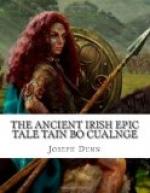[4-4] Stowe.
[a] A pet name for Cuchulain.
[5-5] Eg. 93.
[1-1] Eg. 93 and H. 2. 17.
[2-2] Eg. 93 and H. 2. 17.
[3]Then the young warrior from Faery went from him and they knew not what way he had gone. “Good, O my master Laeg,” said Cuchulain; “together we will go to avenge the youths on the hosts.” “I will go with thee,” Laeg made answer.[3] “And the scythed chariot, my friend Laeg,” said Cuchulain. “Canst thou get it ready? If thou canst get it ready and hast its equipment, make it ready, and if its equipment is not at hand, make it not ready.”
[3-3] Eg. 93 and H. 2. 17.
* * * * *
[Page 187]
XVIIb
THE SCYTHED CHARIOT
[W.2525.] Thereupon the charioteer arose and donned his yeoman’s suit for charioteering. Of this [LL.fo.77a.] yeoman’s suit for charioteering, this is what he put on him: His soft kirtle of skin which was light and airy, which was smooth and sparkling, which was stitched and of buckskin, so that it hindered not the movements of his arms outside. Over that he put outside an over-mantle of raven’s feathers, which Simon Magus had made [1]as a gift[1] [2]for Darius[2] [3]Nero,[3] king of the Romans. Darius bestowed it upon Conchobar; Conchobar gave it to Cuchulain; Cuchulain presented it to [4]Laeg son of Riangabair,[4] his charioteer. The same charioteer took the crested, plated, four-bordered battle-cap with variety of every colour and every figure, reaching [5]down[5] over the middle of his shoulders behind. It was an adornment for him and not an encumbrance. With his hand he placed the red-yellow frontlet—like one red-golden strip of glowing gold smelted over the edge of an anvil—on his forehead as a token of charioteering, to distinguish him from his master. He opened the hobbles that fastened his steeds and grasped his gold-mounted goad in his right hand. In his left hand he seized the lines, that is, the bridle-reins of his horses for restraining his steeds before performing his charioteering.
[1-1] Eg. 93.
[2-2] Stowe and LU. 1874.
[3-3] H. 2. 17 and Eg. 93, instead of, ‘Darius.’
[4-4] Eg. 93 and H. 2. 17.
[5-5] Eg. 93 and H. 2. 17.
[W.2542.] He next threw the iron-sheathed gold-bedecked coats of mail over his horses, so that they covered them from forehead to forehand. [1]The chariot was[1] [2]studded with[2] dartlets, lancelets, spearlets, and hardened spits, so that every portion of the frame bristled with points in that chariot and every corner and end and point and face of that chariot was a passage of laceration.
[1-1] There is a gap in the
MS., and these words are supplied from the
context.
[2-2] Eg. 93 and H. 2. 17.




